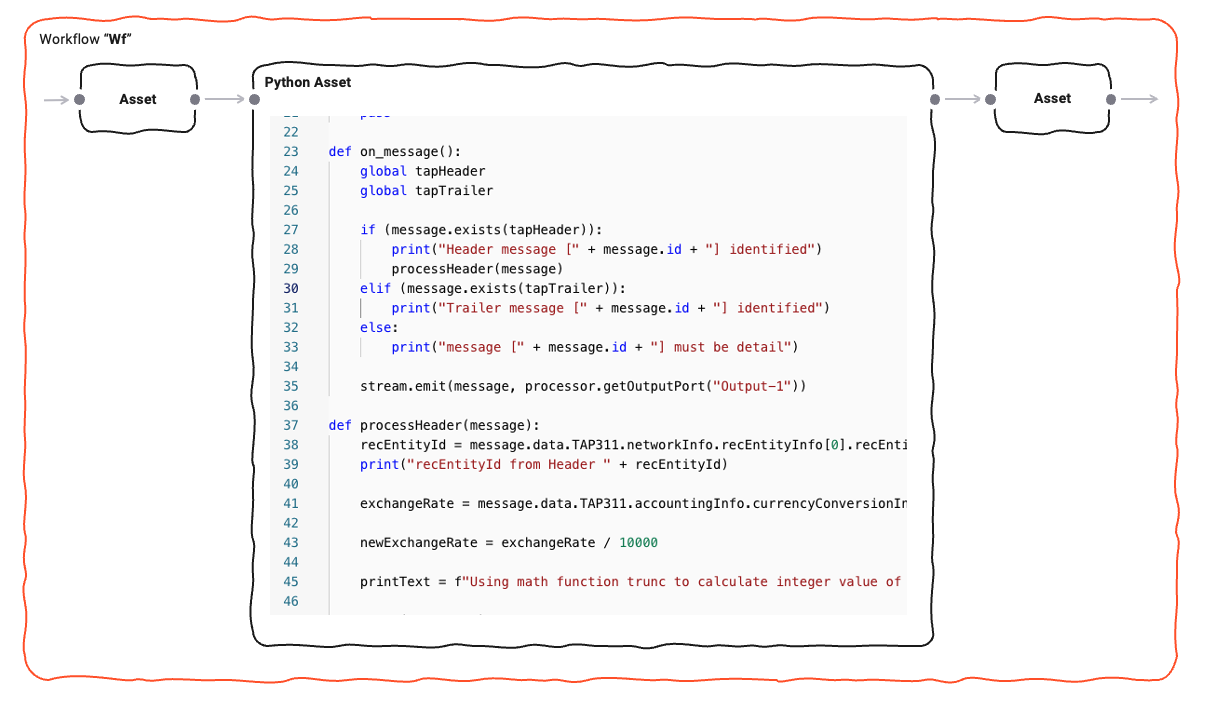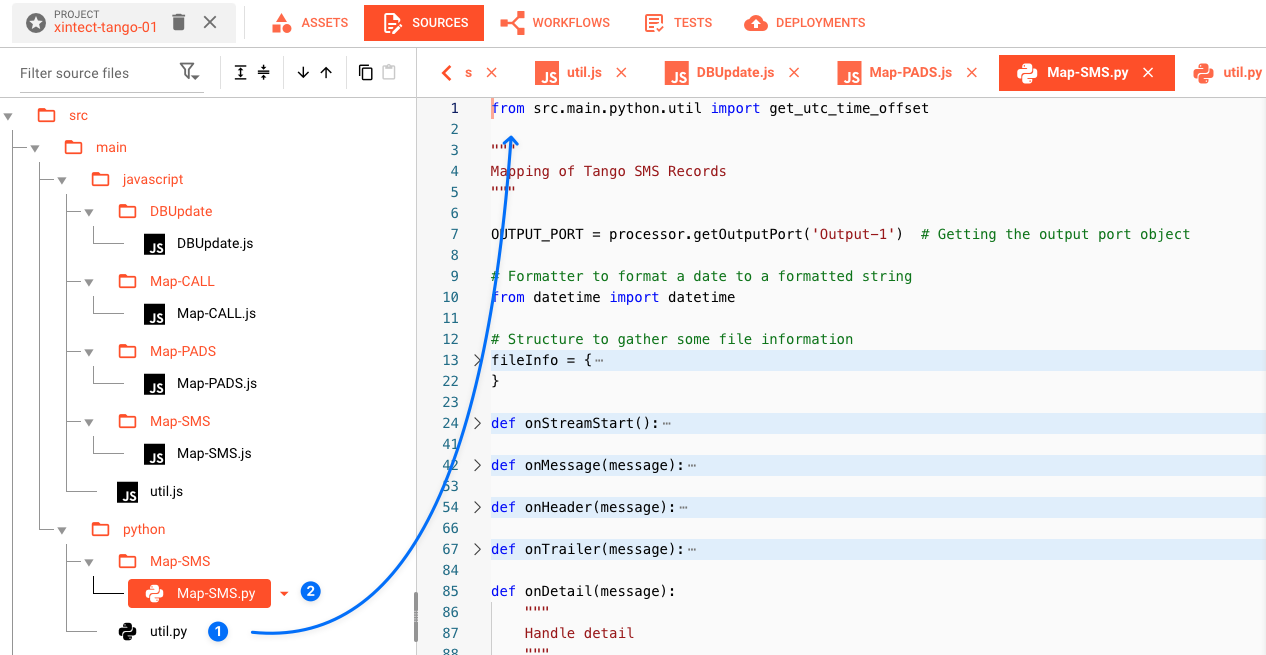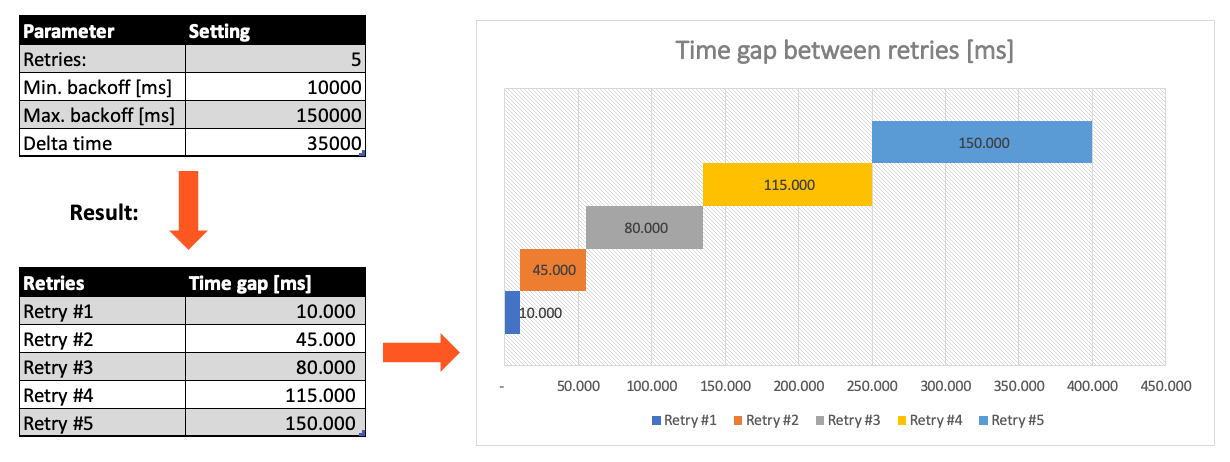Welcome to Python
Introduction
In order to allow for complex message processing and applying custom business logic to message handling, layline.io provides the Python Asset. This asset enables you to apply theoretically any kind of scriptable logic when handling messages.
Popular examples are:
- Data analysis
- Enrichment
- Statistics gathering
- Complex mapping
- Filtering
and potentially anything you can imagine when handling data.
Using the Python Asset is not mandatory of course. Many challenges you may be facing can be accomplished using the out-of-the-box Assets which layline.io provides without resorting to Python. But in many instances, an intermittent scripting processor inserted into a Workflow can go a long way in enabling you to execute logic which would be otherwise hard to implement using pure UI elements.
On this page we will explain how to use Python with the Python Asset.
Scope of Python language
layline.io embeds a Python runtime to facilitate Python scripting.
Limitations: There might be limitations in using Python which are specific to the layline.io environment. Please refer to the layline.io Python documentation for details.
If you want to get familiar with Python outside of layline.io, there are websites for Python tutorials available, like for instance Python.org, to start getting familiar with Python.
How it works - Lifecycle Hooks
Scripts within layline.io can only be executed using the Python Asset. In fact, that's its sole purpose. You can use none, one or as many of these Assets within your Project and within the Project's configured Workflows.
Since layline.io is a reactive system, a Python Asset receiving a message automatically starts processing this message with the underlying script you provided. One of the key methods here is onMessage:

Just like onMessage is a hook, the Python Asset provides a number of additional hooks which are automatically
invoked as part of a Python Asset's lifecycle.
A complete list of these hooks can be found in
the Python Processor Reference.
The following sequence graph shows a typical lifecycle of a Python Processor:
Let's explain:
When a Workflow is instantiated as part of a Deployment (running on a Reactive Cluster), an instantiated Python Processor runs through a number of lifecycle stages:
1. Initialize
On startup of the workflow instance, the Python Processor will be initialized. This is the first stage of the lifecycle and only happens once per workflow instance.
Anything defined on the global level (non-functions) get evaluated. This can be things like variable initialization, getting an output port and assign it to a constant etc. Use this to initialize global variables and constants for example:
# Example
OUTPUT_PORT = processor.getOutputPort('MyOutput')
my_var = None
connection = None
# etc ...
2. on_init()
layline.io then automatically invokes the on_init() method. Again, this is only called once per workflow instance on startup.
on_init() provides a more contained area to perform initializations:
# Example
def on_init():
global connection
connection = services.MyDBService.openConnection()
# etc ...
3. on_stream_start()
When a Workflow starts processing a Stream, a Workflow-wide Stream-start event is issued.
You can hook on to this event using the on_stream_start() Method.
filename = None
def on_stream_start():
global filename
filename = stream.getName()
# etc ...
4a. on_pull_message()
In line with the reactive architecture of layline.io, if the framework is ready and needs to pull the next message from a source, it will invoke the on_pull_message() hook. At this point in time there is no message available for processing in the Python Processor yet. It is merely a signal that the framework is ready to process the next message.
At this stage you can for example do preparations for the next message.
def on_pull_message():
global headerWasGenerated
global OUTPUT_PORT
# prepare for the next message
if not headerWasGenerated:
headerMessage = dataDictionary.createMessage(dataDictionary.type.Header)
headerMessage.data.PRODUCT = {
"RECORD_TYPE" : "H",
"FILENAME" : stream.getName()
}
# stream.logInfo(f"headerMessage.data: {headerMessage.toJson()}")
stream.emit(headerMessage, OUTPUT_PORT)
headerWasGenerated = True
# ...
In most of your processing logic you will not need to use the on_pull_message() hook, but rather use the on_message() method.
4b. on_message()
Every time Python Processor is fed with a message by an upstream Processor, the on_message() hook is invoked.
It is therefore central to message processing and should be used to process the message:
# Get the output port
OUTPUT_PORT = processor.getOutputPort('MyOutput')
def onMessage():
if message.typeName === 'Header':
# do nothing
elif message.typeName === 'Trailer':
# do something with the trailer
elif message.typeName = 'Detail':
# invoke a self-defined function which handles the message.
handle_detail(message)
stream.emit(message, OUTPUT_PORT)
def handle_detail(detail):
# do something with the message
As you can see the current message is accessible via the global and reserved message variable which is an instance of the Message class.
5. on_stream_end()
Finally, when a Stream comes to an end (e.g. the end of an input file or database query), the on_stream_end() hook is automatically called.
Write your code here for finalizing actions regarding the processing of a stream:
def on_stream_end():
# Report in case some customer data could not be found during stream processing
if num_customer_data_not_found > 0:
stream.logInfo(f'{num_customer_data_not_found} customers could not be found in the database.')
6a. on_prepare_commit()
layline.io is transactional by default. This means that a Workflow will only commit if all the Assets in the Workflow have successfully completed.
The on_prepare_commit() hook is the first hook that is called when a stream is about to being committed.
This allows you to make final checks and preparations for the final commit, including sending out messages to the output port.
def on_prepare_commit():
# make final checks and preparations
# ...
6b. on_commit()
The on_commit() hook is called when a stream is successfully committed.
This allows you to make final actions after the commit has been successful, including sending out messages to the output port.
def on_commit():
# make final actions after the commit
def on_rollback():
global connection
if connection:
connection.commitTransaction();
connection.closeConnection();
connection = None
7. on_rollback()
The on_rollback() hook is called when a stream is requested to be rolled back.
This allows you to make final actions to perform a rollback, including potentially sending out messages to the output port.
def on_rollback():
global connection
if connection:
connection.rollbackTransaction();
connection.closeConnection();
connection = None
8. on_prepare_retry()
This hook is invoked when a stream is requested to be retried. This can happen in two ways:
- An Asset has been configured to retry a stream on failure. An example would be a Input Asset which has a respective Failure Handling configured.
- Within a Javascript or Python Processor a
stream.requestRetry()method has been called.
In both cases the on_prepare_retry() hook is invoked to allow you to make final checks and preparations for the retry.
def on_prepare_retry():
# make final checks and preparations
Referencing and Reusing Scripts
python modules are not supported yet, but will be in an upcoming release. Please contact support for more information.
Introduction
Sometimes, you need the same functionality across multiple Scripts. This can be achieved by creating generic scripts containing general functions that can be (re)used in many other scripts.
Creating a reusable script

Here we have created a file util.py (1) which contains one function which we want to reuse on other scripts (2).
You can write your script as you like. All you need to know is that it needs to be valid Python.
Error handling
Unforced errors
Python is an interpreted language. You can therefore encounter unforced errors at runtime. Most of them show up when trying to start a Workflow containing a Python Processor. In this case the Workflow will not start and the cause of error is displayed:

Forced errors
Forced errors occur when you deliberately raise an error at runtime:
try:
insert_result = connection.MyInsert(
{
"DeviceID": message.data.IOT.DEVICE_ID,
"Measurement": message.data.IOT.MEASUREMENT,
"Timestamp": message.data.IOT.TIMESTAMP
}
)
except Exception as error:
close_connection()
raise error
finally:
connection = None
# OR
# raise ValueError("My individual error message: " + my_message)
Raising an error which you do not catch yourself with a try ... except clause, will be bubbled up.
For this purpose a Python Asset provides a number configuration options (which you will also find in other Asset
configurations):

Processing within a Flow Processor like this one can fail for various reasons. In this section you can define how the system should behave in case of such problems.
Failure Types
Four types of failures are observable:
| # | Failure observables / Reaction | Ignore | Retry Event/Message | Retry Stream | Rollback Stream |
|---|---|---|---|---|---|
| 1 | Stream start failure handlingA problem occurred in this Asset when starting a new stream. | ✔ | ✔ | ✔ | ✔ |
| 2 | Stream end failure handlingA problem occurred in this Asset when ending a stream. | ✔ | ✔ | ✔ | ✔ |
| 3 | Message failure handlingA problem occurred when handling a specific message in this Asset. | ✔ | ✔ | ✔ | ✔ |
| 4 | Rollback commit failure handlingA problem occurred during system issued rollback or commit procedure. | ✔ | ✔ | ✔ | ✔ |
Failure Type Reactions
Each of these failure types can be responded to with four different reactions:
Ignore
Don't do anything.
Rollback Stream
Rollback the complete stream. In the case of batch/file processing for example the complete file (which represents the stream) will be rolled back and put into error.
A rollback signal will be issued to all participating Workflow Processors. Each Processor needs to ensure itself how to deal with a rollback. A Javascript Flow Processor, for example, which directly interacts with a database will have to react to a rollback signal:
export function onRollback() {
if (connection) {
try {
connection.rollbackTransaction();
connection.closeConnection();
} catch (err) {
} finally {
connection = null;
}
}
}
Retry Stream
Don't simply give up. Try to process the whole stream again. This option allows you to define how often and in what intervals the retries should be performed.

Stream Retry Settings
Max. Retries: The number of retries which should be performed. For example "5".Min. Backoff [ms]: Wait at least x milliseconds between each retry. For example "12000" (12 seconds).Max. Backoff [ms]: Wait at max x milliseconds between each retry. For example "150000" (150 seconds).
Based on these parameters, the system will try to balance the defined number of retries within the time boundaries of min. backoff and max. backoff. Taken the example numbers from above, the five retries would happen in this timespan:

Retry Event/Message
Pick this reaction if you want to retry processing the current message. As is the case with the Retry Stream reaction you can define how often and in what intervals the retries should be performed.

The settings are the same as with the Retry Stream reaction. So please refer to this.
There is one additional setting, however, which is When final retry failed.
You here have the option to decide what to do if the message cannot be processed, even after the final retry:
-
Ignore: Don't do anything. -
Rollback Stream: Fallback to rolling back the whole stream. -
Retry Stream: Retry the whole stream once again. If you pick this option, then you can again define all relevant Retry Stream parameters.
A Workflow has one Input Processor which is responsible for reading data from a Source. Sources are for example files, databases, or message queues.
The settings for Retry Event/Message and Retry Stream only work for specific Source Types which a Workflow uses.
These are:
Summary
Using these principles, the usage of the Python Asset is straightforward.
You may wonder how big a Python script should get, or how small. Quick answer: It's really up to you. It makes sense to split scripts into logical chunks and then potentially chain a number of scripts together in a Workflow.